Favorite Scene: The Last of the Mohicans (1992)
I’ve wanted to highlight this section of film for some time. Just never got around to it…as usual. But credit two people, longtime reader Cindy and her comment to last month’s post, and one of my favorite authors, Adrian McKinty with his post from awhile back, for getting me off the snide. The 2016 blog post, Top 10 Movies That Are Better Than The Book, gave the initial credence for this piece. The Northern Irishman now living in Melbourne, Australia got straight to the point in his customary manner:
“There are a couple of lists like this floating around the internet but they’re all written by kids who have no idea what they’re talking about because they haven’t A) seen any films or B) read any books. Also you have to scroll through many screens to get their ridiculously uninformed opinions, whereas to get my ridiculously overinformed opinions you need only look below. You can pretty much stop reading any of those other lists at the point where they claim that Clueless is better than Pride and Prejudice. Ahem. Ok my top 10 or 11 if you want to be technical about it.”
Of course, it’s his number one pick that stirred this as Mr. McKinty made a concise, but a straight-to-the-point case for:
“1. Last of the Mohicans. This book is so bad that Mark Twain made hay out of mocking it 150 years ago and it has not aged particularly well since then. The Michael Mann film however, is a classic especially that 8 minute long – almost silent – final sequence.”
And it’s that monumental excerpt, as the author noted, almost entirely wordless, that culminates the film. Famously, the filmmaker had acquired the rights to Philip Dunne’s 1936 screenplay of the then movie, rather than the problematic novel1. Director Michael Mann producing another of his stellar action sequences that mean so much more than the bodies being strewn about. This then my reasons I admire the sequence — a superb set of emotional scenes chained together — that climaxes this film so very well.
Bringing all the principals that have carried the tale to this dramatic close. The three frontiersmen traveling west to find a new home: Chingachgook, the last chief of the Mohican tribe; his son, Uncas, and an adopted brother, a white man named Nathaniel Poe2, aka “Nathaniel Hawkeye.” The British Colonel Munro’s children, Cora and Alice, and the Army Major and a family friend in love with Cora, Duncan Heyward, assigned to escort them to their father’s fort during the French and Indian War of 1757.
Plus, the instigator that has tied them together in a fight for their lives…Magua.
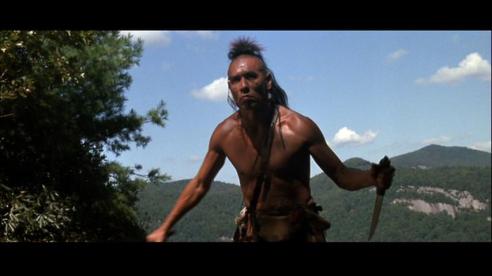
Magua, the clear villain of the film and the most formidable warrior throughout. In fact, he’s the most dynamic and compelling character of the entire production. Certainly, the most skilled at different languages and cultures that come clashing together in the tale. A bitter brew of Huron, Mohawk, French and English. The last what places him on the road to vengeance since he holds Colonel Munro responsible in the death of his children, loss of his wife to another, and care of his eventual enslavement by the allied Mohawk.
He has the clearest incentive, as least by 16th century standards, for unleashing the bloodshed he seeks in this muscular retelling and re-envisioning of Cooper’s story3.
Wouldn’t be a worthy Michael Mann sequence to discuss without something to say musically. Especially since little dialogue exists in this section of the film. The music by Trevor Jones and Randy Edelman4 has to deliver something dramatic to the ears while the director does similarly with actors via action. Titled here as Promontory, it is the scene’s dulcet accompaniment, composed by Jones, and extensively quoting Scottish singer-songwriter Dougie MacLean‘s most famous work, “The Gael” from his 1990 album The Search.
The instrumental track keys the start and end of the sequence to a haunting extent.
The Scene
Mann the quintessential filmmaker, if for nothing more than the vivid realism he wishes to project onto the screen and viewer’s imaginations. As usual, researching details of the story to a high degree (let’s not speak to the mystical investigation he no doubt did for his adaptation of F. Paul Wilson novel of the same name, The Keep, shall we?), gathers his cast and trains them exhaustively to bring off stunts5 and conflicts few others can replicate. Photographing them to a stunning resolution, thematically, as done here.
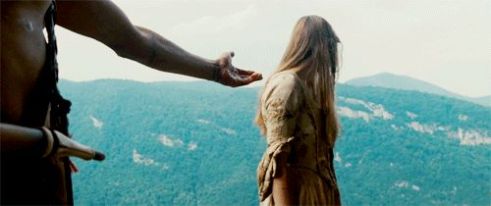
Setup
The entirety of the story has led to this. Magua about to accomplish his full vengeance upon the family Munro in his distant Huron encampment. Having ambushed and killed his arch-enemy, after the fall of Fort William Henry, he presents the British Colonel’s captured daughters and Duncan Heyward to his chief, in hopes of gaining recognition as a war leader. Only to again be interrupted and stymied by Hawkeye, who has come to plead for the lives of the prisoners, with Chingachgook and Uncas nearby.
The appeals by both take unexpected turns as the sachem rules that Heyward is to be returned to the British, with Alice given to Magua to soothe the wrong done him; but Cora sacrificed by fire to settle the debt. Hawkeye asks Heyward, translating between Hawkeye and the elder, to take his life in Cora’s stead. In a final gesture of affection and redemption, Heyward arranges to be executed in her place, though. The betrayed Magua storming off with his band, Alice in tow, and Cora escaping with Hawkeye.
The remainder of the sequence will lead to a bloody and emotional resolution as all of the principals will lose something dear to them6.

And who empowered these colonials to pass judgement on England’s policies, and to come and go without so much as a “by your leave”?
As irksome as Heyward has been throughout upholding British rule amongst the colonials and pressing for Cora’s hand, his last noble act is to frustrate the man who’s outwitted him for the duration, Magua, by keeping his enemy’s oldest from the flame. Knowing Cora loves Hawkeye, and his attempts are for not, Heyward’s offer also a selfish one. Only the Le Longue Carabine has any chance of delivering Cora to safety, and the long range marksmanship to end his suffering from the slow, gruesome death before him.
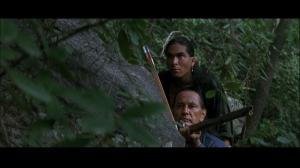 Which brings us to the quietest pair on both sides of the cultural divide represented in the story. As mentioned, Uncas, who’s supposed to be the “last of the Mohicans” by Chingachgook’s thinking to this point, “…is the unspoken spirit of this work”. “Emblematic of the indigenous people’s fate…” Here separating from his father’s side to go and rescue whom he loves, Alice, from her captor. The future consort, Magua. Getting out front of the band along the cliff side as they head away from the Huron camp.
Which brings us to the quietest pair on both sides of the cultural divide represented in the story. As mentioned, Uncas, who’s supposed to be the “last of the Mohicans” by Chingachgook’s thinking to this point, “…is the unspoken spirit of this work”. “Emblematic of the indigenous people’s fate…” Here separating from his father’s side to go and rescue whom he loves, Alice, from her captor. The future consort, Magua. Getting out front of the band along the cliff side as they head away from the Huron camp.
The director will visually telegraph Uncas fate with the first warrior he cuts down and forces him off the cliff.
Ambushing, then taking out the lead warriors one by one, by rifle blows, shot, and tomahawk, Uncas sets his sights on Magua in that way we’ve come to expect from Michael Mann. Quick, brutal, and authentic methods of combat using period weaponry in close-quarter action. Credit the filmmaker for again defying Hollywood convention in making such a fight to the death overly stylized when these two begin to trade with edged weapons. Or that Uncas’ tomahawk duel stands a chance against Magua’s skilled use of both knife and ax.
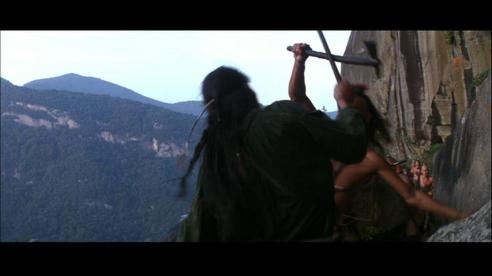
It’s bloody and one-sided, and all to the dismay of Alice witnessing it. The young British maiden given modest screen time in this story version, Jodhi May would allude her best scenes only made it to the cutting room floor. Still, Mann made sure her’s a fitful dramatic arc. Mostly portrayed as the epitome of “the weak sister” for Cora to protect, she’ll rise to the occasion during the siege of the fort earlier. Her unconsummated feelings toward Uncas laid bare without a word, simply by glance with he who’s vanquished him.
Proof that the filmmaker’s “show, don’t tell” accomplished more visually than Cooper ever could describe on paper with her final act to join Uncas at the bottom of the cliff as the tide in Jones’ music is heard to lament.
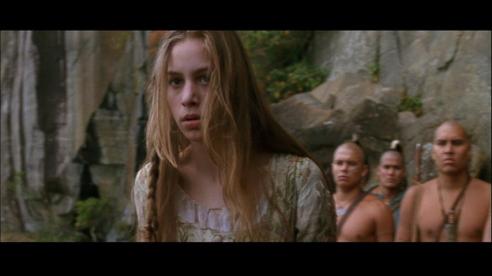
Must be said, the longtime collaborator, Dante Spinotti, framed and minimally lit the sequence to an extraordinary level. Composing characters, as he had throughout, against the picturesque Blue Ridge Mountains of North Carolina (standing in for the Adirondacks region of the period). The imposing splendor of the scenery highlighting the heroic tragedy with epic beauty. Painstakingly in between the rugged backdrop and emotional motivations, which set off to deliver this climatic sequence for Michael Mann only too well.
The fluid camera-work also noted an interesting sideline — that after rescuing Cora, Hawkeye’s role in the final minutes of the film becomes one of support to his adopted father, Chingachgook, as he futilely races to save his kin.
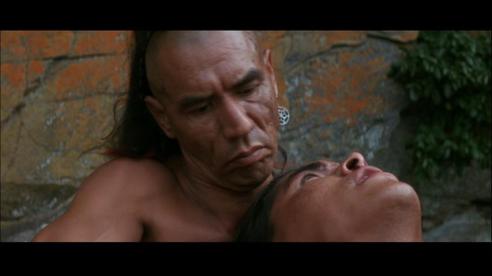
Indicative of the telling anguish of those witnessing the carnage playing forth, it’s shown via close-up on the principals’ faces. Cinematically, Spinotti and Mann made sure every character loses something cherished in the sequence — even if it’s simply their own life. Not cheaply, either. With certainty, they made the casualty side of the French and Indian War skirmish well-earned with masterful visual storytelling, judging by the audience’s reaction to it all. None more so than Chingachgook’s counter to Magua’s last deed in his cruel retribution.
It’s a Hollywood cliché for the movie’s hero to defeat the villain, even the author had Hawkeye pull that one off in his novel. Thankfully, Mann’s keyed off of George B. Seitz’s 1936 film, instead. Yet, rather than Uncas’ father drowning Magua, his merciless demise administered shrewdly and with the filmmaker’s hallmark for ruthless realism. By Chingachgook’s gunstock war club he’s used for the whole of the movie. Deftly negating the villain’s tomahawk and knife prowess by range and leverage for a satisfyingly swift retaliation.
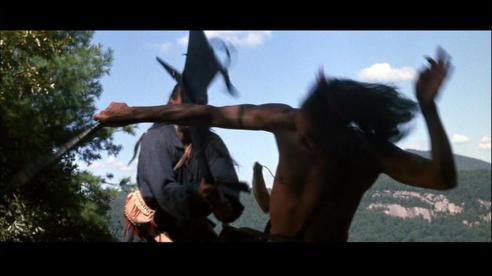
The whole of it how the father brings to bear the vengeful force of the club upon his son’s killer. Negating each of Magua’s fearsome weapons, and limbs, in methodical swift succession as a result. Adroitly rolling under from Magua’s attempted tomahawk strike and out of his line, Chingachgook delivers his own to the opponent’s left side from behind. Then, the right elbow, and tomahawk, the first to go when the Huron attempts to counter, quickly followed up with a stifling body blow to the side holding the knife.
Bringing the penultimate crushing club upon the shoulder to ensure it’ll never raise a blade, ever, before Magua’s (and the audience’s) stunted realization of the final resolution about to land. The two men eyeing each other in the most visually impactful image of the film in preparatory to the war club’s spear point. Typical of Michael Mann, it is that final peak of violent action, with its precise blows that disarm with hot-blooded purpose, which is truly emblematic for one of the greatest cinematic climaxes ever put on film.
- James Fenimore Cooper’s “classic” novel remains a point of contention for not only academics (recommended read, Jane Hill’s Michael Mann’s Last of the Mohican’s Radicalizing Cooper) as well to the native people of the Americas (recommended read, An Indigenous Peoples’ History of the United States by Roxanne Dunbar-Ortiz). ↩
- Mann dropping the “Natty Bumppo” moniker from Cooper’s protagonist from his pentalogy of novels known as the Leatherstocking Tales. ↩
- The clip used for this examination will be from Michael Mann’s initial 112-minute theatrical release, not the 117-minute “expanded edition” for its U.S. DVD release (November 23, 1999), or the 114-minute October 5, 2010 U.S. Blu-ray release, billed as the “Director’s Definitive Cut.” You can tell by Magua’s body wound shown, refer to Movie-Censorship.com’s comparison of film versions. ↩
- Jones and Edelman did not work together on the score and why their names on the credits are separate from one another. The latter came on board due to creative differences between Trevor Jones and Michael Mann, which forced the former off the project. The subsequent soundtrack album reflects this as the first half is Jones’ score followed by Edelman’s and ending with Clannad’s song. ↩
- “Michael Mann wouldn’t allow the actors to use stand-ins.” ~ IMDB ↩
- The most distinctive differences between source novel and Mann’s reinterpretation lay with who lives and dies. Colonel Munro and Major Heyward both survive in the novel. Alice dies at the end of the movie, as does her rescuer Uncas (the only consistent demise in both), but Cora is stabbed by a warrior and Magua shot by Hawkeye at the end in Cooper’s tale. ↩

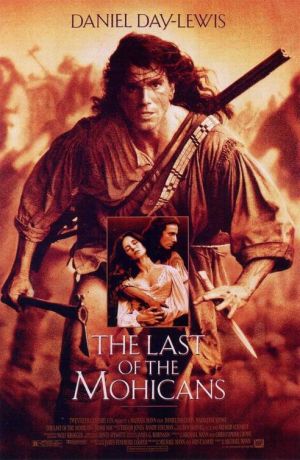
31 Responses to “Favorite Scene: The Last of the Mohicans (1992)”
🙂 Uncas! Well, I’ve seen this film 50 times and I never tire of it. Other than the sound (talking behind a waterfall is not advisable), the final scene as you so eloquently describe it with all the lovely back bits thrown in is marvelous, Michael. The score is a personal favorite.
LikeLiked by 1 person
Ya stay ahlive. Ir well come back for ya!
LikeLiked by 1 person
Sigh. I wish DDL would make a new movie. I miss him.
LikeLiked by 2 people
You might be in luck, I’m pretty sure he’s got one in the pipeline.
LikeLiked by 1 person
Oohh! I wonder what?
LikeLiked by 2 people
Could well be this:
https://www.theguardian.com/film/2017/jan/31/daniel-day-lewis-on-location-whitby-paul-thomas-anderson
LikeLike
Mate why aren’t you like working for Buzzfeed or something. Nice write up of a classic scene.
LikeLiked by 1 person
Thank you very kindly, Lloyd. Much appreciated, my friend. 🙂
LikeLiked by 1 person
Fabulous piece, Michael. Absolutely superb. This is a real beauty of a film from Mann and still one of his very best. The sequence in question is riveting stuff and never ceases to leave me breathless every time. And Magua? He’s one of the all-time great villains for sure. Wes Studi is never given enough credit in that role.
LikeLiked by 2 people
Oh, I so agree that Wes Studi doesn’t get enough credit for this role. Agreed, one of the all-time great villains, for sure. Many thanks, Mark. 🙂
LikeLiked by 2 people
Once again, you have given us an insightful and richly described look at a great sequence. Certainly this will encourage another dozen or so rewatches by your readers. I will include myself among those. Excellent.
LikeLiked by 1 person
Thank you, Richard. 🙂
LikeLike
Absolutely tremendous post of one of my favorites! “Proof that the filmmaker’s “show, don’t tell” accomplished more visually than Cooper ever could describe on paper with her final act.” YES. 100% YES. That final act is pure brilliance. I need to go re-watch this now after reading this…I keep hearing DDL in my head saying, “i WILLLLLL find you!”
LikeLiked by 2 people
Thank you very much for the kind words, Courtney. 🙂
LikeLiked by 1 person
Yer stay ahlive. I well fend ya!
LikeLiked by 1 person
Fascinating, Michael. Thank you.
(And a little nod to your colleague for his pithy filleting of bratty opinionistas).
LikeLiked by 1 person
Yeah, Adrian has a way with words. Thanks, Bruce. 🙂
LikeLiked by 1 person
Ah, gutting all over again.
LikeLiked by 1 person
Cinematic trauma at its best! 😉
Thanks, Jay. 🙂
LikeLike
I was wondering which scene you were going to go for here and this one is a cracker. Not Mann’s best film but it’s still hugely watchable and this scene is very powerful. Nice choice sir!
LikeLiked by 1 person
Thank you very much, Mark. 🙂
LikeLiked by 1 person
Great write up Michael, I love this film ever since I saw it way back in my early teens. And this climatic sequence was spectacular! Loved everything about it, the excellent score, beautifully choreograph action and perfect cinematography. I’m hoping Mann would be go back and release the 3 hours version that studio demanded him to cut down to current version. Apparently that version include the love story between Uncas and Alice.
I tried reading the novel but couldn’t get past the first few chapters, glad to hear it wasn’t that great.
LikeLiked by 1 person
Yeah, this is one of those that is truly memorable from the moviegoing perspective. Especially, if it was seen firsthand in the movie theater. I’d love to see a Mann-approved expanded cut of this, for sure. Many thanks, Ted. 🙂
LikeLike
G’day mate, just nominating you for The Mystery Blogger Award for all your great work. https://lloydmarken.wordpress.com/2017/02/22/the-mystery-blogger-award-nomination/ Have a nice day.
LikeLiked by 1 person
Thank you very kindly, Lloyd. Much appreciated, my friend. 🙂
LikeLiked by 1 person
I have seen this movie and in my opinion for what its worth is that I think it is an excellent movie, very well worth the time to watch it a second time.
LikeLiked by 1 person
Welcome and thank you, oldpoet56. It is, indeed. 🙂
LikeLike
Good afternoon (as it is here). Try as I might I cannot find the essay by Jane Hill referred to above. Do you have an up-to-date link? With thanks
LikeLike
Hello, Simon. Looks like that link is broken, and the content moved to a fileshare. As mentioned here: http://7.weldedpipemills.ru/9
LikeLike
[…] feature film debut with Thief and his later Los Angeles revisit via Collateral. Even his remake of The Last of the Mohicans. The little I’ve done previously for this particular movie relegated to scrutinizing its […]
LikeLike
[…] and emotional effect in one of the greatest cinematic climaxes ever put on film, as mentioned here. This instrumental is the essence of that […]
LikeLike